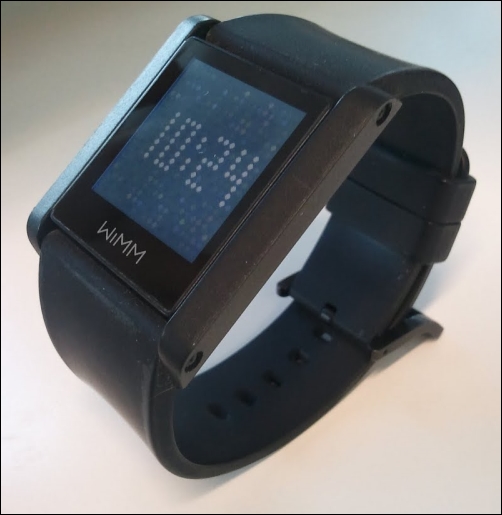In the smart era of technology, it was expected that every possible gadget would work smarter. Wristwatches were no exception. The type of watches changed from analog to digital, and now to purely computerized smartwatches. Being a very flexible open source operating system, Android is one of the most favorite option for smartwatches (image source: http://photos.appleinsidercdn.com/bigger-wimm-130830.jpg):

From the very early versions, Android watches were well capable of playing games, thus entering the game development domain. Advanced devices are as good as small computers. They consist of the Internet, sensors, cameras, Bluetooth, Wi-Fi, speakers, card slots, and have many more features.
Like other computers, a smartwatch may collect information from internal or external sensors. It may control, or retrieve data from, other instruments or computers. It may support wireless technologies like Bluetooth, Wi-Fi, and GPS. However, it is possible that a "wristwatch computer" may just serve as a frontend for a remote system, as in the case of watches utilizing cellular technology or Wi-Fi.
Android Wear was first announced on March 18, 2014 by Google. At the same time, many manufacturers of electronic gadgets were announced as partners of Android Wear. These companies include Samsung, Motorola, LG, HTC, ASUS, and others.
In December 2014, the operating system was upgraded to Android 5.0 (Lollipop). We can see a series of Android Watch releases around this period of time. LG started shipping LG G Watch, Motorola announced Moto 360, and ASUS released ZenWatch.
The latest advanced watches offer a set of attractive features. Users can find directions by voice from the phone, choose a transport mode, including a bike, and start a journey. While travelling, the watch shows directions, and will actually use tactile interaction to indicate turns by feel, helping the wearer travel without looking at a phone, or even the watch screen. Users can use their Android Wear watch to control their phone. Music can be requested (for instance, "OK Google, play the Rolling Stones"). The screen then shows a card for play-control, volume, skip, and media images, and music can be controlled from the wrist with the user free to move around.
Let's look at a few specifications of Android wearable devices. First, the LG G Watch:
|
Processor |
Qualcomm Snapdragon 400 |
|
Flash memory |
4 GB |
|
RAM |
512 MB |
|
Battery |
400 mAh |
|
Connectivity |
Bluetooth 4.0 |
|
Sensors |
Gyro, accelerometer, compass |
|
Android version |
4.3 |
|
Display |
1.6 inch |
|
Resolution |
280x280 |
This configuration does not exist anymore in the market, but users do. So while making a game for an Android wearable, the developer should take into account these configurations as well.
Android wearable manufacturers are also upgrading their devices with massive hardware changes. Now let's have look at the evolution of devices by comparing two releases:
|
Sony Smartwatch 2 |
Sony Smartwatch 3 | |
|---|---|---|
|
Processor |
ARM Cortex M4 |
ARM A7 quadcore |
|
Speed |
180 MHz |
1.2 GHz |
|
Flash memory |
256 MB |
4 GB |
|
RAM |
64 MB |
512 MB |
|
Battery |
225 mAh |
420 mAh |
|
Connectivity |
Bluetooth 3.0 |
Bluetooth 4.0 and Wi-Fi ready |
|
Sensors |
Gyro, accelerometer, compass, proximity, ambient light, and IP57 dust and water resistant |
Gyro, accelerometer, compass, proximity, ambient light, and IP68 dust and water resistant |
|
Android version |
4.0 |
4.3+ |
|
Display |
1.6 inch |
1.6 inch |
|
Resolution |
220x176 |
320x320 |
We can observe a huge boost in terms of technical and hardware upgradation here. This is how the market is growing, and the applications as well.
